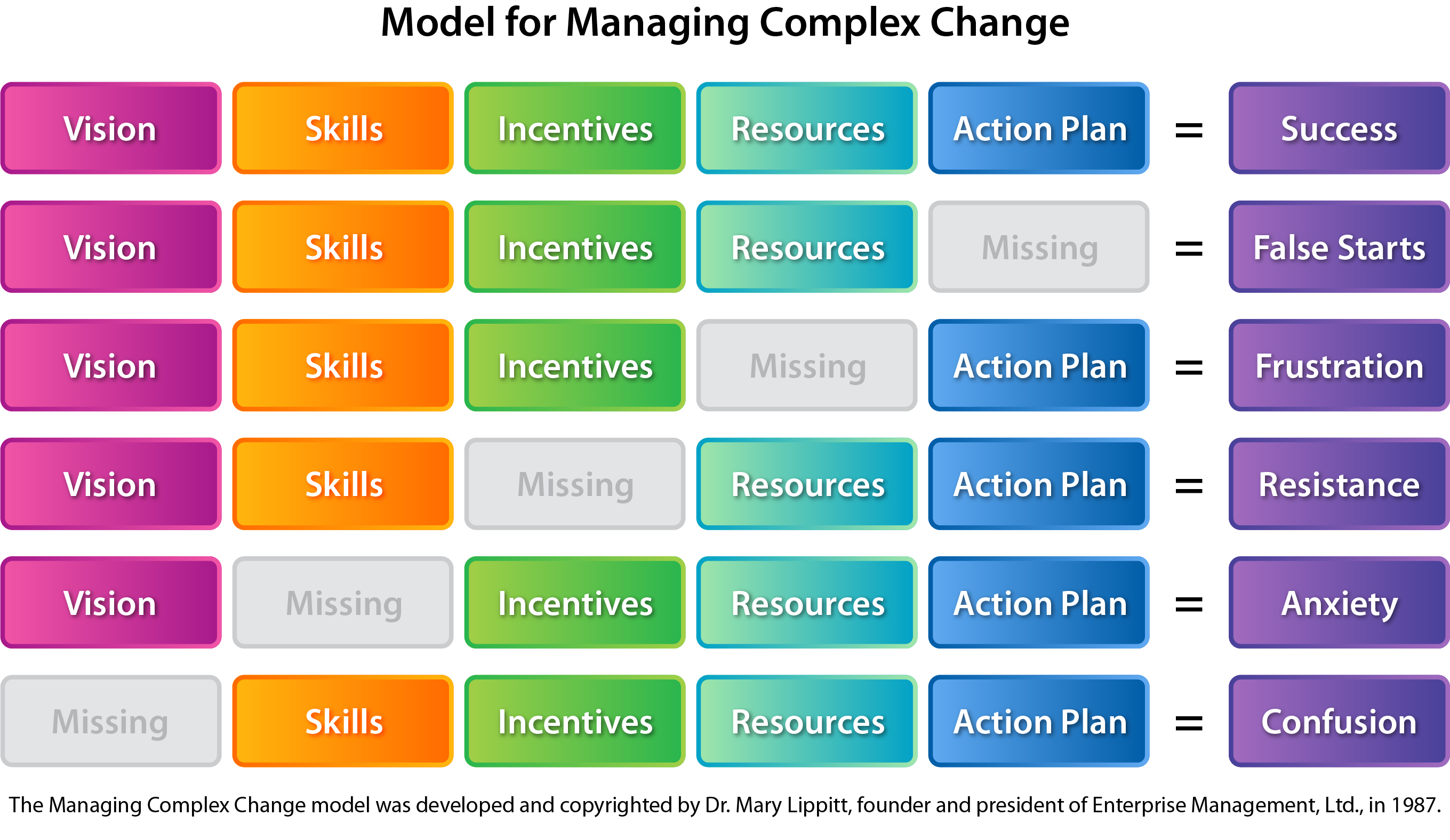Manage Complex Change: Keeping Your Shared Vision for Readiness in Mind

Complex change in schools is both necessary and challenging. Drawing on Mary Lippitt’s Integrated Change Management Model, this resource explores actionable strategies for managing complex change effectively in schools.
OBJECTIVES
- Understand the necessity and challenges of change in schools
- Apply Mary Lippitt’s Integrated Change Management Model to educational settings
- Implement actionable strategies for leading sustainable change
The Six Elements of Change
Mary Lippitt’s model highlights six critical elements for successful change. Each element plays a vital role in ensuring the change process is cohesive, sustainable, and impactful. Missing even one of these components can undermine the effort, leading to confusion, resistance, or inefficiency.
Vision
A shared understanding of the change’s purpose.
Why It’s Important: Without a clear vision, stakeholders may not understand the “why” behind the change, leading to misalignment and lack of enthusiasm. A compelling vision provides direction and serves as a rallying point for the community.
Practical Example: When introducing a new SEL program, ensure the vision articulates how it will enhance student well-being, readiness, and academic success. This clarity helps unite staff, parents, and students around a common goal.
Skills
The abilities required to implement the change.
Why It’s Important: Even with a strong vision, change can falter if stakeholders lack the skills needed to carry it out. Skill gaps create anxiety and hesitation, eroding confidence in the initiative.
Practical Example: Teachers implementing a new digital platform, such as Canvas, need hands-on training to navigate its features effectively. This ensures that they feel capable and supported throughout the transition.
Incentives
Motivation and alignment with stakeholder values.
Why It’s Important: People are naturally more invested in change when they see how it aligns with their personal or professional goals. A lack of meaningful incentives can lead to apathy or active resistance.
Practical Example: Highlight how dual credit courses benefit students by providing a head start on college, while also emphasizing how the initiative supports teachers by offering professional growth opportunities and new instructional resources.
Resources
Adequate tools, time, and support.
Why It’s Important: Without sufficient resources, even the most enthusiastic and skilled individuals will struggle to achieve results. Resource gaps create frustration, burnout, and a sense of futility.
Practical Example: When launching a new program, ensure that teachers have access to lesson plans, instructional materials, and adequate preparation time. Providing a dedicated instructional coach can also alleviate pressure and offer ongoing support.
Action Plan
A clear roadmap to guide the change process.
Why It’s Important: A lack of structure and defined roles can lead to false starts, where confusion about responsibilities causes delays and inefficiencies. A detailed action plan provides clarity and accountability.
Practical Example: For a curriculum redesign initiative, break the process into phases with timelines, specific deliverables, and assigned leads. Use tools like project management software to monitor progress and adapt the plan as needed.
Leadership Support
Consistent advocacy and involvement from leaders.
Why It’s Important: Leadership involvement signals commitment and provides the guidance necessary to navigate challenges. Without it, change efforts risk stagnating or losing momentum.
Practical Example: School leaders can model change by actively participating in professional development sessions, addressing concerns transparently, and celebrating milestones to sustain enthusiasm and engagement.

The Impact of Missing Elements
When any of these components are absent, change efforts falter:
- Lack of Vision leads to confusion about goals and priorities.
- Lack of Skills creates anxiety and reduces confidence.
- Lack of Incentives results in resistance or disengagement.
- Lack of Resources causes frustration and inefficiency.
- Lack of an Action Plan results in disorganization and stalled progress.
- Lack of Leadership Support fosters stagnation and uncertainty.
Change is the law of life. And those who look only to the past or present are certain to miss the future.
– John F. Kennedy
Practical Insight: A school attempting to implement a technology shift without sufficient training (skills) or a clear rollout plan (action plan) often experiences pushback from teachers who feel overwhelmed. However, when schools clarify responsibilities, allocate time for professional development, and show leadership support, these obstacles are minimized.
By addressing each of these elements thoughtfully, schools can transform their change initiatives into opportunities for growth and success.
Strategies for Leading Complex Change

Anchor the Change in Shared Identity and Vision for Readiness
Change initiatives are most effective when tied to a school’s core values and identity. For example, when introducing dual credit courses, focusing on how the program supports student confidence, readiness, and exposure to diverse learning environments helps align the initiative with the school’s mission.
Tip: Use your school’s vision as a touchstone to guide decisions and unite stakeholders around a common purpose.

Build Trust Through Family and Community Partnership
Successful change requires collaboration among teachers, administrators, and the community. Collaborative approaches help address concerns, ease transitions, and build buy-in. For instance, when transitioning from one technology platform to another, understanding and respecting staff needs was key to success.
Tip: Include stakeholders early in the process to foster trust and shared ownership.

Align Incentives with Goals
Clear incentives motivate staff and stakeholders to embrace change. For instance, dual credit courses provide opportunities for teachers to deepen their understanding of university-level instruction and access professional resources. Recognizing and rewarding these benefits helps sustain momentum.
Tip: Celebrate milestones, provide professional growth opportunities, and connect change to personal and organizational benefits.Share the final draft or recording with the student and their family.

Provide the Right Resources
Insufficient tools or support can derail change efforts. For example, implementing a new instructional platform like Canvas requires robust training and resource allocation to ensure educators feel confident and capable.
Tip: Audit existing resources and address gaps proactively to avoid unnecessary frustrations.

Develop a Clear Action Plan
A well-defined roadmap with clear responsibilities is essential. Change processes often falter when roles and timelines are vague. Breaking the process into manageable phases and assigning ownership ensures clarity and accountability.
Tip: Use visual tools like Gantt charts to track progress and adapt plans based on feedback.

Communicate Effectively and Reflect Often
Clear communication and regular reflection sustain change efforts over time. Accessible language, tailored to different audiences, ensures that everyone understands their role and the broader goals. Reflection creates opportunities to assess progress and adjust strategies.
Tip: Avoid jargon, solicit feedback, and prioritize open dialogue to keep the process on track.
Anchoring Change to Identity and Vision
Managing complex change in schools demands a balance of vision, strategy, and empathy. By applying Lippitt’s model and anchoring change efforts in collaboration and communication, school leaders can transform challenges into opportunities. Treating education as a community endeavor—where reflection and adaptability drive progress—ensures that change efforts are both meaningful and sustainable.
What changes are you leading in your school? Begin by assessing how well your vision, skills, resources, and incentives align with your goals. With the right strategies and support, your efforts can make a lasting impact.
Stay in the Loop
Subscribe to Our Newsletter
The Managing Complex Change model was developed and copyrighted by Dr. Mary Lippitt, founder and president of Enterprise Management, Ltd., in 1987.
This model is frequently credited to other authors who have used the work, such as Timothy Knoster who presented a derivative at a conference in 1991, however Dr. Mary Lippitt is the original author and copyright holder. This model is frequently described as the Knoster model or Lippitt-Knoster model, although that is incorrect.






Responses